
ARCHIVES OF DERMATOLOGICAL RESEARCH
Scope & Guideline
Exploring Breakthroughs in Dermatological Science
Introduction
Aims and Scopes
- Clinical Dermatology:
The journal publishes research focusing on the diagnosis, treatment, and management of various skin conditions, including but not limited to psoriasis, eczema, acne, and skin cancers. - Dermatopathology:
Research that investigates the microscopic and molecular aspects of skin diseases, contributing to better diagnostic and therapeutic approaches. - Innovative Treatment Modalities:
Emphasis on novel therapeutic strategies, including biologics, phototherapy, and emerging treatments such as gene therapy and stem cell therapy. - Public Health Dermatology:
Studies focusing on the epidemiology of skin diseases, health disparities, and the impact of social determinants on dermatological care. - Patient-Centered Research:
Research that prioritizes patient experiences, quality of life, and adherence to treatment, reflecting the growing trend towards patient-focused care in dermatology. - Technological Advancements:
Investigation into the use of technology in dermatology, including teledermatology, artificial intelligence, and imaging techniques to enhance diagnosis and treatment. - Genetics and Molecular Biology:
Exploration of the genetic and molecular underpinnings of skin diseases, including studies on biomarkers and genetic predisposition.
Trending and Emerging
- Teledermatology and Digital Health:
The COVID-19 pandemic has accelerated interest in teledermatology, with numerous studies exploring its effectiveness, patient satisfaction, and integration into standard dermatological practice. - Psychodermatology:
An increasing recognition of the psychological aspects of dermatological conditions, with research focusing on the mental health impacts of skin diseases and the bidirectional relationship between skin health and psychological well-being. - Health Disparities and Social Determinants of Health:
Research highlighting the impact of race, ethnicity, and socioeconomic status on dermatological care, emphasizing the need for equitable access to treatment. - Biologics and Novel Therapies:
There is a growing body of literature on the use of biologic therapies and other innovative treatments for chronic skin diseases, particularly psoriasis and atopic dermatitis. - Microbiome Research:
Emerging studies on the role of the skin microbiome in health and disease, including its impact on conditions such as acne, eczema, and psoriasis. - Artificial Intelligence in Dermatology:
The integration of AI technologies in diagnostics and treatment planning is a rapidly evolving area, with studies focusing on the accuracy and efficiency of AI tools in dermatological practice. - Patient-Centric Approaches:
An increasing focus on patient-reported outcomes and experiences in research, reflecting a shift towards more personalized and patient-centered care in dermatology.
Declining or Waning
- Traditional Dermatological Practices:
There is a noticeable decrease in studies focusing solely on traditional methods of treatment, such as topical steroids and antibiotics, as newer therapeutic modalities gain prominence. - Descriptive Epidemiological Studies:
While epidemiological research remains important, there is a declining emphasis on purely descriptive studies without actionable insights or interventions related to dermatological conditions. - Single-Center Studies:
The prevalence of single-center studies appears to be diminishing, with a growing preference for multicenter or population-based studies that provide more generalizable results. - Basic Science Research:
There seems to be a shift away from purely basic science research in dermatology, towards translational studies that bridge laboratory findings with clinical applications. - Case Reports:
The number of case reports published has decreased, likely due to the preference for studies that provide broader insights or systematic reviews rather than isolated clinical observations.
Similar Journals

JOURNAL OF THE AMERICAN ACADEMY OF DERMATOLOGY
Leading the way in skin science and clinical excellence.JOURNAL OF THE AMERICAN ACADEMY OF DERMATOLOGY, published by Mosby-Elsevier, stands at the forefront of dermatological research and education. With an impressive impact factor and categorized as Q1 in Dermatology, this journal has established itself as a pivotal resource for healthcare professionals and researchers in the field. Since its inception in 1979, it has provided a platform for high-quality peer-reviewed articles, contributing significantly to advancements in dermatological science and practice through 2024. The journal commands an honorable position, ranking #8 out of 142 in the Scopus database's medicine dermatology category, placing it in the 94th percentile among its peers. Readers can access a wealth of cutting-edge studies, case reports, and reviews that address a broad spectrum of topics, from clinical dermatology to emerging therapies. In addition, the journal's commitment to excellence ensures it remains an essential tool for students, clinicians, and researchers dedicated to improving skin health and furthering knowledge in dermatology.
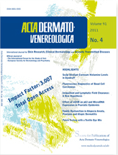
ACTA DERMATO-VENEREOLOGICA
Connecting researchers and practitioners through impactful findings.ACTA DERMATO-VENEREOLOGICA, published by the esteemed ACTA DERMATO-VENEREOLOGICA since 1945, stands as a leading open-access journal in the fields of Dermatology and Venereology. With an impressive Q1 categorization in both Dermatology and Miscellaneous Medicine, this journal ranks at the 82nd percentile among its peers, highlighting its pivotal role in disseminating cutting-edge research. Accessible to all since 1998, it provides a vital platform for sharing original studies, reviews, and insights on skin-related disorders and treatments, fostering knowledge expansion among researchers, professionals, and students alike. The journal's commitment to high-quality, peer-reviewed content ensures that it remains a trusted resource aimed at advancing dermatological science. Based in Uppsala, Sweden, ACTA DERMATO-VENEREOLOGICA continues to contribute significantly to the global discourse in dermatological health.

BRITISH JOURNAL OF DERMATOLOGY
Exploring the frontiers of skin science and treatment.The British Journal of Dermatology, published by Oxford University Press, stands as a premier platform for advancing the field of dermatological research and clinical practice since its inception in 1892. With a strong commitment to disseminating high-quality research, this esteemed journal is currently ranked in the Q1 category for both Dermatology and Miscellaneous Medicine in 2023, reflecting its influential position in the academic landscape. As the leading journal in its field, it enjoys a robust Scopus ranking of #1 out of 142 in dermatology, placing it in the 99th percentile globally. The journal covers a wide scope of subjects pertinent to dermatology, including clinical trials, treatment innovations, and epidemiological studies, making it an essential resource for researchers, healthcare professionals, and students alike. Although it is not an open-access publication, it ensures a broad reach through institutional subscriptions, fostering knowledge exchange across the global dermatological community. Based in the heart of the United Kingdom, the British Journal of Dermatology continues to play a crucial role in shaping the future of skin health and disease management.
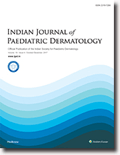
Indian Journal of Paediatric Dermatology
Connecting experts in paediatric skin health.Indian Journal of Paediatric Dermatology (ISSN: 2319-7250; E-ISSN: 2319-7269), published by Wolters Kluwer Medknow Publications, stands as a pivotal resource in the specialized field of paediatric dermatology. As a peer-reviewed open access journal since 2013, it aims to disseminate cutting-edge research, clinical practices, and innovative developments that cater to the specific dermatological needs of children. The journal provides an essential forum for collaboration among researchers, clinicians, and students, facilitating the sharing of knowledge on a wide array of topics, including skin conditions unique to paediatric populations, treatment methodologies, and advancements in dermatological care. With a commitment to enhancing the understanding and treatment of paediatric skin diseases, this journal plays a critical role in shaping best practices and informing future research directions in a rapidly evolving field.
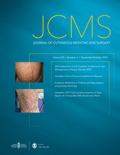
JOURNAL OF CUTANEOUS MEDICINE AND SURGERY
Empowering professionals with cutting-edge research in dermatology.The Journal of Cutaneous Medicine and Surgery is a premier publication in the fields of dermatology and surgery, dedicated to advancing the scientific understanding of skin-related conditions and surgical techniques. Published by SAGE Publications Inc, this esteemed journal features a rich repository of peer-reviewed research, reviews, and clinical studies, ensuring that it remains at the forefront of dermatologic and surgical innovation. With an impressive impact factor and a ranking in the top quartile (Q1) of both dermatology and surgery categories for 2023, it is recognized as a vital resource for professionals, researchers, and students alike. The journal has consistently made significant contributions to the knowledge base that guides clinical practice and surgical decision-making, fostering a deeper understanding of the complexities involved in cutaneous medicine. For comprehensive updates, researchers can access this journal through SAGE’s platform, which supports the dissemination of high-quality research findings to a global audience.
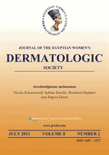
Journal of Egyptian Womens Dermatological Society
Bridging Gaps in Women's Dermatological CareThe Journal of Egyptian Women's Dermatological Society, published by Wolters Kluwer Medknow Publications, is an essential platform dedicated to advancing the field of dermatology through a valuable focus on women's health issues. Established to provide an open access outlet since 2019, this journal aims to disseminate research, case studies, and reviews that address the unique dermatological needs and concerns of women, particularly in the Egyptian context. Despite its current ranking in the Q4 category in dermatology and a Scopus rank of #117 out of 142 with a 17th percentile, the journal serves a critical role in fostering scholarly communication among researchers, clinicians, and academicians. With a commitment to promoting knowledge advancement and community engagement, this journal invites submissions that align with its objectives, specifically geared towards empirical research and innovative practices in dermatology impacting women's health.

JOURNAL OF DERMATOLOGICAL TREATMENT
Exploring the forefront of skin health research.The JOURNAL OF DERMATOLOGICAL TREATMENT, published by TAYLOR & FRANCIS LTD, is a premier forum dedicated to advancing the field of dermatology through the dissemination of high-quality research. Since its inception in 1989, this journal has maintained a significant impact on the dermatological community, currently ranking in the top quartile (Q1) of the Dermatology category with an impressive Scopus ranking of #14 out of 142 journals, reflecting its reputation among peers and its contribution to the clinical and academic landscape. The journal shifted to Open Access in 2023, enhancing the accessibility of groundbreaking findings to researchers, clinicians, and students worldwide. With a commitment to publishing diverse articles, from innovative treatment modalities to comprehensive reviews, the JOURNAL OF DERMATOLOGICAL TREATMENT serves as an invaluable resource for professionals seeking to stay at the forefront of dermatological science in a rapidly evolving field.

Journal of Dermatology & Dermatologic Surgery-JDDS
Unveiling Breakthroughs in Skin Science and SurgeryJournal of Dermatology & Dermatologic Surgery (JDDS) is a premier open access journal published by Wolters Kluwer Medknow Publications since 2018. This journal serves as a vital platform for the dissemination of cutting-edge research and advancements in the field of dermatology and dermatologic surgery. With its ISSN 2352-2410 and E-ISSN 2352-2429, JDDS strives to present high-quality articles that encompass clinical studies, innovative surgical techniques, and comprehensive reviews, thereby catering to the interests of researchers, medical professionals, and students alike. The journal has gained recognition within the academic community, evidenced by its Scopus ranks, placing it 237th out of 551 in the Medicine - Surgery category and 70th out of 142 in Medicine - Dermatology. The open access model not only enhances visibility but also encourages global collaboration and knowledge sharing in the rapidly evolving field of dermatology. Targeting the needs of diverse audiences, JDDS continues to foster an environment for scholarly communication and contributes significantly to the advancement of dermatologic sciences.
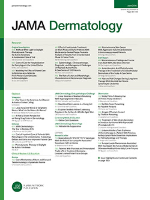
JAMA Dermatology
Empowering Knowledge in Dermatology and Beyond.JAMA Dermatology, an esteemed publication by the American Medical Association, is positioned at the forefront of dermatological research and clinical practice. With an ISSN of 2168-6068 and an E-ISSN of 2168-6084, this journal underscores a commitment to disseminating high-quality and impactful research within the field. Notably ranked Q1 in both Dermatology and Miscellaneous Medicine for 2023, JAMA Dermatology ranks among the top journals in its category, holding the impressive 3rd position out of 142 in Scopus's dermatology rankings, placing it in the 98th percentile. With converged years extending from 2013 to 2024, the journal emphasizes timely and critical advancements in dermatological science. Furthermore, as a champion of open access, it encourages a broad dissemination of knowledge, making essential research accessible to a wider audience. Researchers, professionals, and students alike will find JAMA Dermatology to be an invaluable resource for the latest findings, innovative therapies, and in-depth reviews that shape the future of dermatological health.
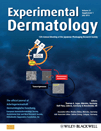
EXPERIMENTAL DERMATOLOGY
Fostering Breakthroughs in Skin Health ResearchEXPERIMENTAL DERMATOLOGY, published by WILEY, is a leading journal in the fields of Biochemistry and Dermatology, with impressive rankings including Q1 status in both categories as of 2023. With its ISSN 0906-6705 and E-ISSN 1600-0625, the journal offers a reputable platform for disseminating cutting-edge research and insights into skin biology and related health issues. As a pivotal resource for professionals, researchers, and students alike, EXPERIMENTAL DERMATOLOGY includes a broad scope of topics, fostering a deeper understanding of dermatological conditions and enhancing new therapeutic strategies. The journal’s distinguished performance is highlighted by its Scopus rankings, which place it at the 91st percentile in Medicine-Dermatology and the 65th in Biochemistry. While not an open-access publication, the journal remains committed to ensuring the accessibility of crucial developments within the dermatological community worldwide, facilitating the advancement of both clinical practice and academic inquiry.